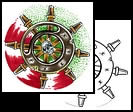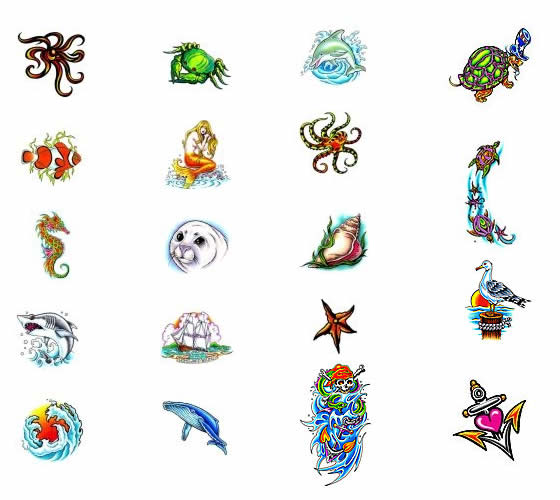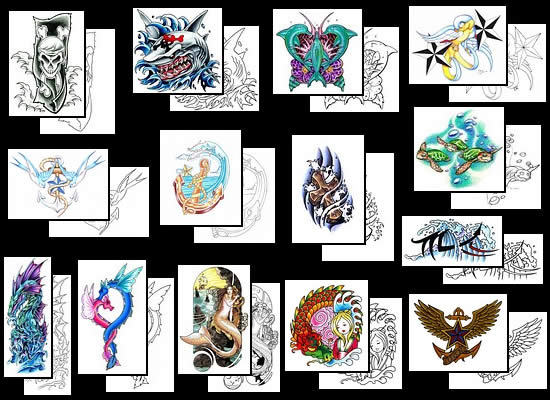|
TATTOO DESIGNS & SYMBOLS - NAUTICAL or MARITIME
Tattoo Symbol Index -
A
B
C
D
E
F
G
H
I
J
K
L
M
N
O
P
Q
R
S
T
U
V
W
X
Y
Z
Tattoo designs - N >>
Nautical
 Nautical or Maritime Tattoo Meanings -
are tattoos derived from the very roots and history of modern
tattooing. Sailors were among the first to revive the art and
practice of tattooing when they visited the islands of Polynesia in
the South Pacific and other lands in Southeast Asia. Captain Cook in
his famous explorations to Tahiti, Hawaii and New Zealand was the
first to record the tattooing of the indigenous people in 1786. The
word tattoo in the English language come from the Tahitian word, 'ta-taw',
which was thought to mimic the sound made by the traditional
Polynesian tattooing implements as they made a tattoo. When the
sailors returned to Europe with tattoos that were essentially exotic
souvenirs of their travels and adventures, European audiences were
fascinated. Nautical or Maritime Tattoo Meanings -
are tattoos derived from the very roots and history of modern
tattooing. Sailors were among the first to revive the art and
practice of tattooing when they visited the islands of Polynesia in
the South Pacific and other lands in Southeast Asia. Captain Cook in
his famous explorations to Tahiti, Hawaii and New Zealand was the
first to record the tattooing of the indigenous people in 1786. The
word tattoo in the English language come from the Tahitian word, 'ta-taw',
which was thought to mimic the sound made by the traditional
Polynesian tattooing implements as they made a tattoo. When the
sailors returned to Europe with tattoos that were essentially exotic
souvenirs of their travels and adventures, European audiences were
fascinated.
|
|
Life at sea was hard and only the toughest men survived. Sailors,
being at the mercy of the wind and the sea and the elements, and the
very capriciousness of Mother Nature, were a very superstitious lot.
It did not take long for them to build up an extraordinarily
elaborate set of tattoo symbols that spoke a language all their own.
Tattoos told the story of were a sailor had traveled, if he had been
around Cape Horn or crossed the Equator, if he had visited the
Orient. |
Many nautical tattoos were amulets and talismans of protection
to keep from falling overboard, drowning or being eaten by a shark.
From tattooing the words on their knuckles, to numerous tattoo
designs and symbols like the Nautical Star that were meant to keep
them safe and guide them safely back to their home port. Many
sailors used to tattoo images of their full-rigged ships on their
bodies, often taking up large spaces on their chest, backs and arms
to pay respects to their homes upon the waves. Often times, despite
their often raucous and rowdy lifestyle, many sailors would have
religious images and icons tattooed upon their backs, sometimes even
full Psalms or the Lord's Prayer. Part of this was to remind
themselves to be virtuous, but it was also believed that you were
less likely to as flogged as severely if you got twenty lashes
across your back for misbehaving!
The expression Stewed, Screwed and Tattooed comes from this Maritime
tradition - it was a colourful synopsis of shore leave for many
sailors after having spent many months at sea! A good port of call
for men who worked at sea often earned it's reputation by the
qualities - or lack thereof - of it's drinking establishments, women
and tattoo artists.
 And of course many sailors at sea often thought of their families
and the girls they had left behind in port, whether it was one port
or two ports or even more! Mermaids and pin-up girls, hearts and the
names of loved ones were always popular with sailors. And of course many sailors at sea often thought of their families
and the girls they had left behind in port, whether it was one port
or two ports or even more! Mermaids and pin-up girls, hearts and the
names of loved ones were always popular with sailors.
Get
inspired by some really great images and photos in our Nautical Inspiration Gallery
See also:
Nautical Tattoo Index,
Marine Life Tattoos
Choose your own nautical tattoo design from Tattoo-Art.com.
Find and buy the nautical tattoo design that's perfect for yourself.

Nautical tattoo designs by some of the
world's top tattoo artists & illustrators at TattooJohnny.com.

Some Sailor Tattoo Traditions
Tattooing HOLD on the fingers of the right hand, just below the
knuckles, and FAST in the same place on the left hand, in the hopes
that it would keep the sailor from losing his grip high in the
riggings of the ship.
A Swallow tattoo
was for a sailor who logged five thousand miles at sea. At ten
thousand miles a sailor could add a second Swallow. Swallow tattoos
were also thought to be good luck in finding land and in returning
to your home port.
An Anchor usually
meant that a sailor had sailed across the Atlantic Ocean.
A Sea Turtle
showed that a sailor had sailed across the Equator
A Dragon tattoo
showed that a sailor had sailed into a port in China.
A Golden Dragon was for sailors who had crossed the International
Date Line.
A Rope Knot, was meant to denote a Four Knot Sailor, or one who had
crossed the Equator, International Date Line, Arctic and Antarctic
circles.
A Full-Rigged Ship meant that a sailor had made the passage around
Cape Horn.
Traditionally, a sailor who had rounded Cape Horn was entitled to
wear a gold loop earring — in the left ear, the one which had faced
the Horn in a typical eastbound passage — and to dine with one foot
on the table; a sailor who had also rounded the Cape of Good Hope
could place both feet on the table.
Another tradition holds that the practice of wearing gold hoops or
earrings among sailors was that should you drown at sea and wash up
on a strange shore, the gold in the earring would pay for a decent
Christian burial.
Another source says that in addition to the
Full-Rigged Ship tattoo
that a sailor was entitled to get for having rounded Cape Horn, he
could also get a small blue
star on the left
ear. Five times 'round the Cape, and you could add a star to the
right ear. And if you were a salty enough old sea-dog to make the
perilous passage ten times, you were entitled to two red dots on
your forehead!
A Pig tattooed on the top of one foot, and a Rooster tattooed on the
top of the other foot - so that if the sailor did fall into the
water they would quickly make it to land because it was thought that
pigs and roosters couldn't swim!
A Shark tattoo was
to prevent a sailor from being eaten if they fell overboard by the
sharks that often trailed after sailing ships, especially whaling
ships, looking for scraps. No sailor wanted to be dinner scraps for
a shark!
Rock of Ages,
and other religious imagery was often tattooed on the back to ensure
that the First Mate might not flog you too badly.
Port and Starboard ship lights - Port (left) and Starboard (right) -
were tattooed on either side of the body. It was also thought that
such tattoos would help a sailor stay on the right course.
Nautical Star
tattoos were to guide a sailor home.
Compass tattoos
were also meant to guide a sailor home.
Propellers were tattooed on the buttocks to propel a sailor through
life. Usually a tattoo favored by sailors who were stokers, and who
shovelled coal deep in the belly of a ship to fuel the boilers that
powered steam ships.
Rope, tattooed around a wrist denoted that the sailor was a
deckhand.
Oil Here, around the belly button means a ship's engineer - or
'snipe'.
A tattoo of Crossed
Anchors was meant to denote a Boatswains Mate.
Pin-up Girls,
Hula Girls and
Mermaids were all tattoos to remind sailors what awaited them in
Port.
Mermaid tattoos
were also thought to be lucky if you fell overboard.
See also: Bluebirds,
Dolphins,
Jolly Roger,
Jesus,
Polynesian
Tattooing,
Pirates,
Praying Hands,
Heart, Homeward
Bound, Scripts
and Scrolls,
Skull and Cross Bones,
Seals
Tattoo designs - N >>
Nautical
Tattoo Symbol Index -
A
B
C
D
E
F
G
H
I
J
K
L
M
N
O
P
Q
R
S
T
U
V
W
X
Y
Z
|







